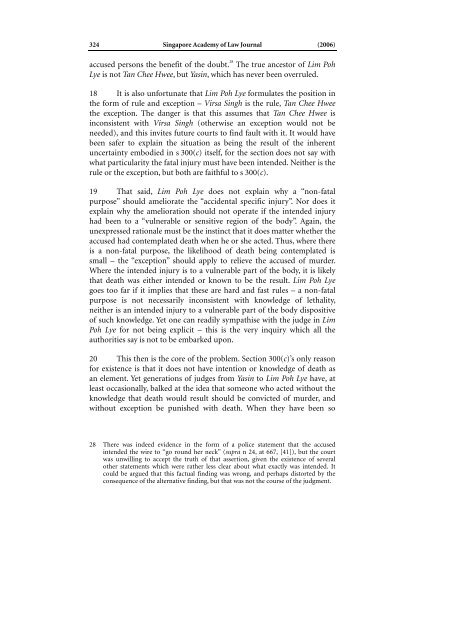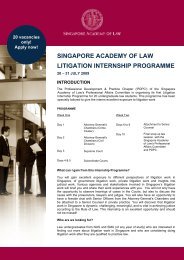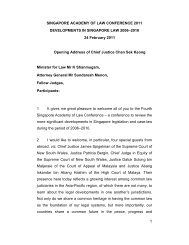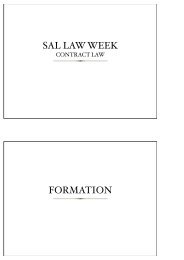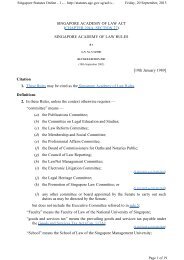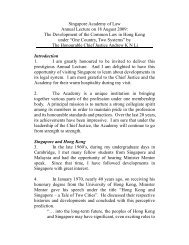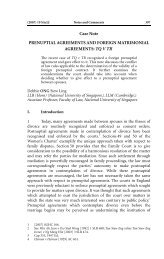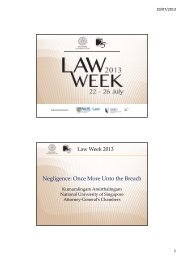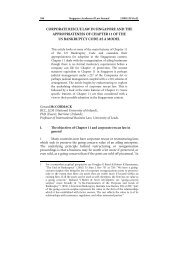2. Managing Mens Rea in Singapore - Singapore Academy of Law
2. Managing Mens Rea in Singapore - Singapore Academy of Law
2. Managing Mens Rea in Singapore - Singapore Academy of Law
Create successful ePaper yourself
Turn your PDF publications into a flip-book with our unique Google optimized e-Paper software.
324S<strong>in</strong>gapore <strong>Academy</strong> <strong>of</strong> <strong>Law</strong> Journal (2006)accused persons the benefit <strong>of</strong> the doubt. 28 The true ancestor <strong>of</strong> Lim PohLye is not Tan Chee Hwee, but Yas<strong>in</strong>, which has never been overruled.18 It is also unfortunate that Lim Poh Lye formulates the position <strong>in</strong>the form <strong>of</strong> rule and exception – Virsa S<strong>in</strong>gh is the rule, Tan Chee Hweethe exception. The danger is that this assumes that Tan Chee Hwee is<strong>in</strong>consistent with Virsa S<strong>in</strong>gh (otherwise an exception would not beneeded), and this <strong>in</strong>vites future courts to f<strong>in</strong>d fault with it. It would havebeen safer to expla<strong>in</strong> the situation as be<strong>in</strong>g the result <strong>of</strong> the <strong>in</strong>herentuncerta<strong>in</strong>ty embodied <strong>in</strong> s 300(c) itself, for the section does not say withwhat particularity the fatal <strong>in</strong>jury must have been <strong>in</strong>tended. Neither is therule or the exception, but both are faithful to s 300(c).19 That said, Lim Poh Lye does not expla<strong>in</strong> why a “non-fatalpurpose” should ameliorate the “accidental specific <strong>in</strong>jury”. Nor does itexpla<strong>in</strong> why the amelioration should not operate if the <strong>in</strong>tended <strong>in</strong>juryhad been to a “vulnerable or sensitive region <strong>of</strong> the body”. Aga<strong>in</strong>, theunexpressed rationale must be the <strong>in</strong>st<strong>in</strong>ct that it does matter whether theaccused had contemplated death when he or she acted. Thus, where thereis a non-fatal purpose, the likelihood <strong>of</strong> death be<strong>in</strong>g contemplated issmall – the “exception” should apply to relieve the accused <strong>of</strong> murder.Where the <strong>in</strong>tended <strong>in</strong>jury is to a vulnerable part <strong>of</strong> the body, it is likelythat death was either <strong>in</strong>tended or known to be the result. Lim Poh Lyegoes too far if it implies that these are hard and fast rules – a non-fatalpurpose is not necessarily <strong>in</strong>consistent with knowledge <strong>of</strong> lethality,neither is an <strong>in</strong>tended <strong>in</strong>jury to a vulnerable part <strong>of</strong> the body dispositive<strong>of</strong> such knowledge. Yet one can readily sympathise with the judge <strong>in</strong> LimPoh Lye for not be<strong>in</strong>g explicit – this is the very <strong>in</strong>quiry which all theauthorities say is not to be embarked upon.20 This then is the core <strong>of</strong> the problem. Section 300(c)’s only reasonfor existence is that it does not have <strong>in</strong>tention or knowledge <strong>of</strong> death asan element. Yet generations <strong>of</strong> judges from Yas<strong>in</strong> to Lim Poh Lye have, atleast occasionally, balked at the idea that someone who acted without theknowledge that death would result should be convicted <strong>of</strong> murder, andwithout exception be punished with death. When they have been so28 There was <strong>in</strong>deed evidence <strong>in</strong> the form <strong>of</strong> a police statement that the accused<strong>in</strong>tended the wire to “go round her neck” (supra n 24, at 667, [41]), but the courtwas unwill<strong>in</strong>g to accept the truth <strong>of</strong> that assertion, given the existence <strong>of</strong> severalother statements which were rather less clear about what exactly was <strong>in</strong>tended. Itcould be argued that this factual f<strong>in</strong>d<strong>in</strong>g was wrong, and perhaps distorted by theconsequence <strong>of</strong> the alternative f<strong>in</strong>d<strong>in</strong>g, but that was not the course <strong>of</strong> the judgment.


